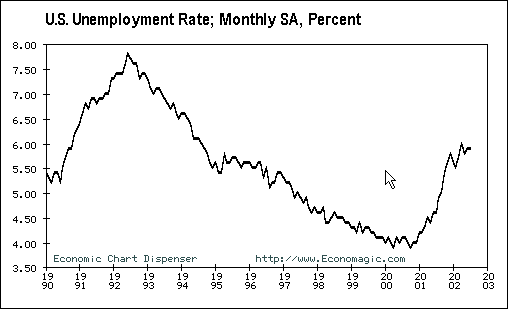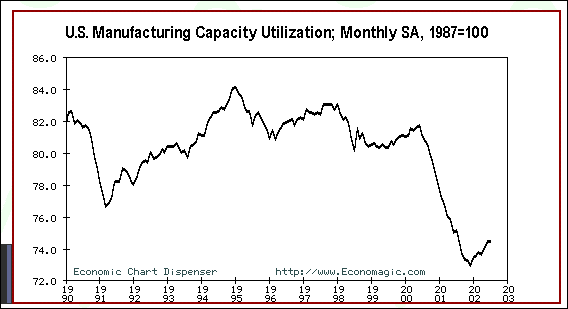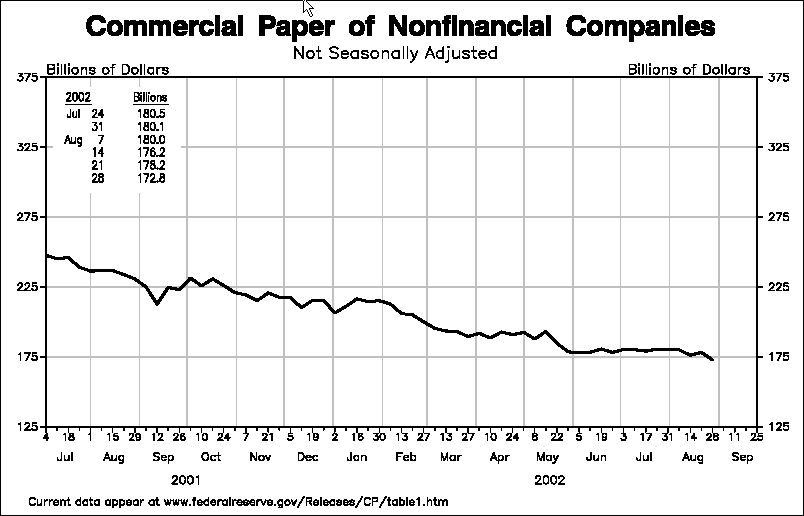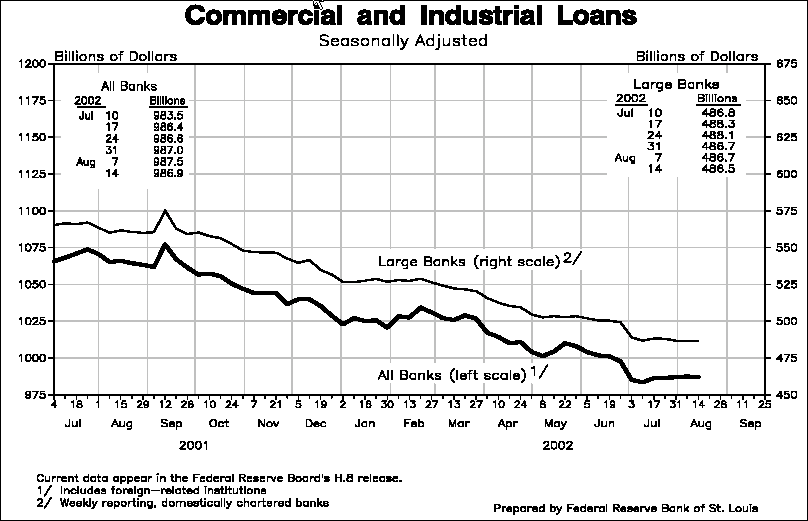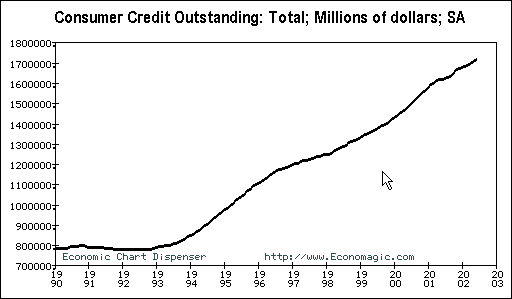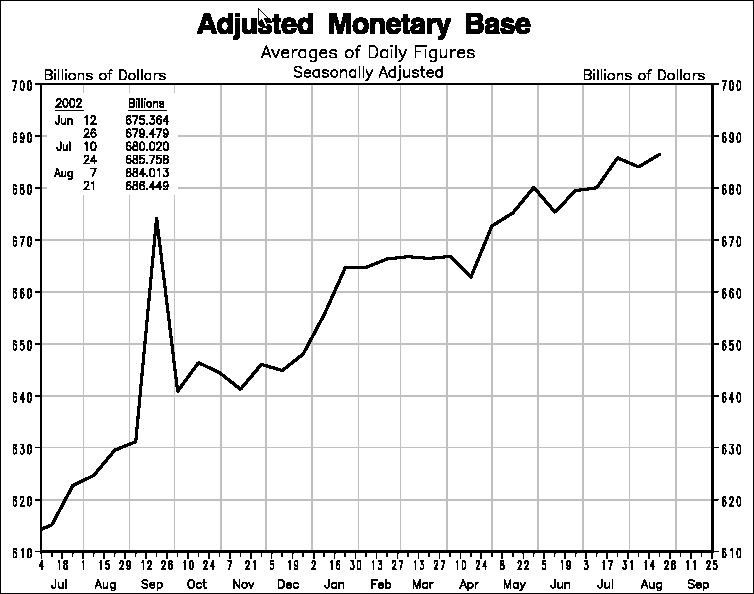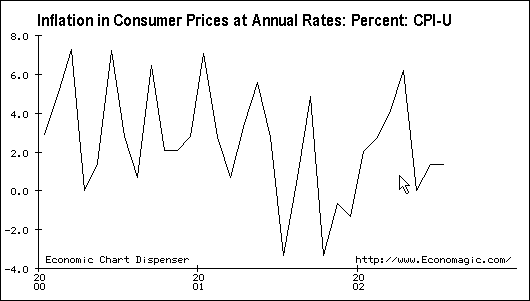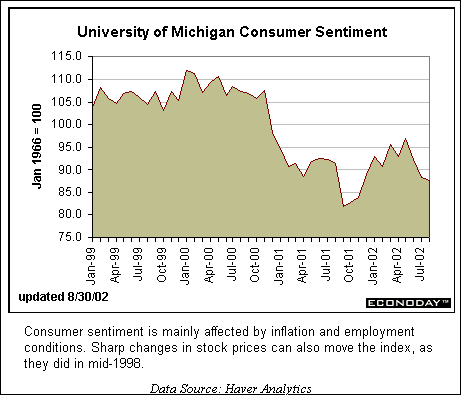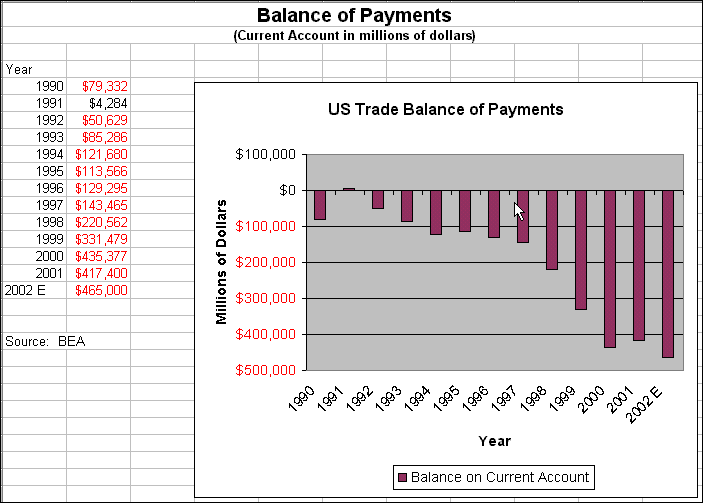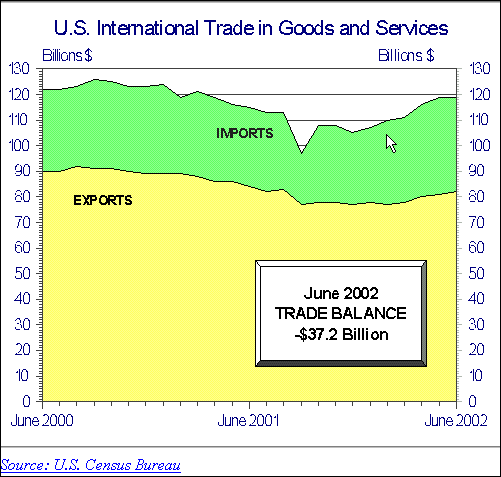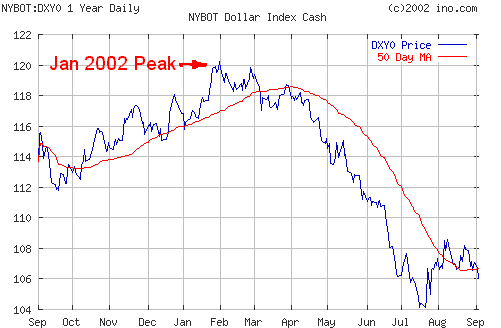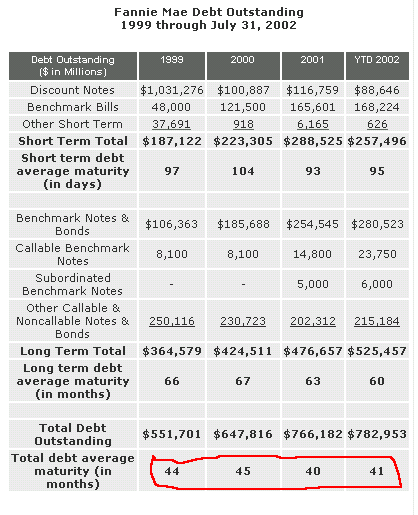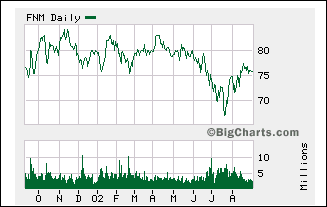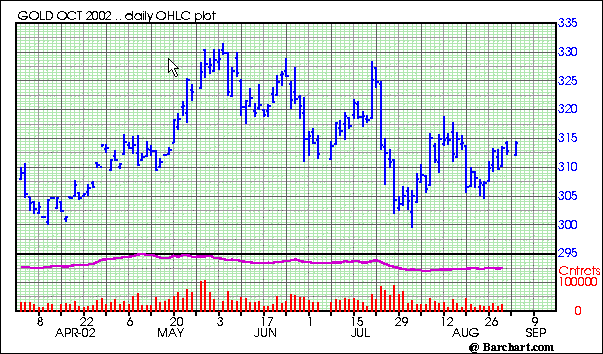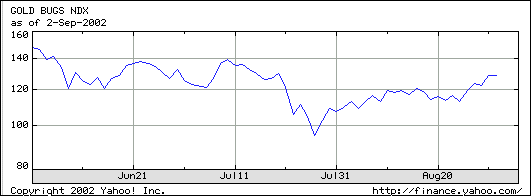Did we ever get out of the recession? |
|
Despite the government statistics, it is beginning to dawn
on many that:
It is becoming increasing evident that the economy has been held up by refinancing that reduces home equity positions, the low-end housing market which has benefited from low or no, down payment mortgages, and government spending. The unemployment rate continues to show little signs of improving as companies continue to downsize. Consolidated Freightways, the nation's third largest trucking carrier, announced plans on Monday, September 2nd to file for Chapter 11 reorganization laying off over 15,000 workers nationwide and messing up shipments for many organizations that rely on the LTL (less-than-truckload) carrier.
|
|
Is capacity utilization recovering? |
|
The answer to that is hardly as shown in the following chart. Capital spending is still in the doldrums. Until capacity utilization improves significantly, capital spending will not improve.
|
|
Low interest does not guarantee economic recovery. |
|
|
During the past several decades, central banks have often lowered interest rates in an effort to increase economic activity. In many instances, the formula has been unsuccessful, the most notable recent example being Japan. Commercial paper and commercial loans are falling at the faster rate in history. Unless corporate loan demand increases, there can be no recovery.
As my old friend, Donn Morgan says, "I cannot see much evidence here of a recovery or a severe contraction, just slow errosion." Bob Chapman reports:
|
|
Consumer Credit continues to grow. |
|
These charts suggest that the economy has hardly any forward progress despite the continued increases in consumer credit to record levels.
In the latest reports issued last week, consumer spending was up 1.0% over the prior period while personal income showed no growth. Obviously, consumer credit must be continuing to increase. Zero interest loans available on auto's, large appliances, and furniture have enabled many consumers to continuing their spending. I can only wonder when the spigot will get turned off.
|
|
The Fed has provided the liquidity to the banking system. |
|
To offset the pressures caused by the reduction in foreign capital inflows and to provide the liquidity for the continued refinancing of home equities as well as the defense of the dollar, the Fed has continued to increase the monetary base. On Thursday 8/29/02 the FED pumped $11.75 billion into the banks via three repurchase agreements early in the A.M. During the last twelve months, MZM increased 12.7%, M-1 5.2%, M-2 7.9% and M-3 7.4%. Despite the increase in the money supply inflation is officially 1.6%. But to the government, there is no inflation. Of course not, if you decide what you want to count and dismiss everything else. Almost every honest economist will tell you that an increasing amount of money chasing the same or fewer goods can only result in inflation.
Of course, one must be aware that the methodology for calculating the Consumer Price Index has only changed eight times since 1996. So just what are we measuring? |
|
Is the consumer still enthusiastic? |
|
|
The University of Michigan's consumer sentiment index fell to 87.6 in the final report for the month of August. The level was down from 88.1 in the final report to July. The chart shows the trend over the past few years.
The chart indicates to me that the consumer is beginning to have doubts about the economy and its recovery. As consumer spending and the consumer's willingness to take on an increasing debt load has carried the economy in recent years, the recent decline in consumer sentiment has to concern federal policy makers. |
|
Globalization and NAFTA have decimated our manufacturing base. |
|
During the past 30 years, the movement of our manufacturing facilities offshore parallels the change of the U.S. status from being the world's largest creditor nation to its largest debtor. The following chart chronicles the steep decline in the U.S. trade deficit.
Our insatiable demand for low-cost costs in discount stores and oil is largely responsible for the tremendous growth in our balance of payments deficit. June was trumpeted as being an improvement although the June trade deficit was still the second largest in history. Some improvement.
Despite a 17% decline is the US dollar since January, US Exports have not risen significantly. One reason is that the U.S. manufacturing capacity has moved overseas. A second reason is that the world economy is not in great shape. The old adage . . . "when the U.S. gets the flu, the rest of the world gets pneumonia" is true. Other than agriculture, avionics, high end computer technology, and oil field equipment, the ability of the U.S. to export products has changed dramatically since 1990. Apparel, shoes, fabrics, many fabricated products, and machine tools are no longer manufactured in the U.S. As the factories have moved to lower wage countries, it should be obvious to our policy makers that increasing exports is going to be extremely difficult in the future. Of course, the most frightening aspect of this policy is that without the manufacturing infrastructure, our capability of building military equipment has been greatly compromised. Two years ago, a report to the Defense Department warned that as the Defense Department had sold as surplus the equipment to make rifle, mortar, and heavy artillery ammunition, the ability to rebuild war stocks of these items was of major concern. And many components of our so-called smart weapons had to be acquired from companies located outside of the U.S. Over twenty years ago, the dearth of our manufacturing capability became starkly clear to me. We tried for over six months to find capable tool and die makers for our company and were unable to find any skilled workers to fill the positions. It is seriously doubtful if the situation has changed today. |
|
The dollar is in trouble! |
|
Since January 2002, the U.S. dollar has lost approximately 17% of its value against the trade-weighted dollar index as shown in the following chart.
From the July 24th bottom, the central banks have made a concerted effort to stop the slide of the dollar. However, the price action of the last two weeks indicates that the effort has lost steam and that the dollar slide will test the July lows and perhaps, move considerably lower. One of the major forces affecting the dollar is the increase of oil prices to the $30 range in anticipation of a Mid-east war. Another factor is the failure of U.S. export to increase dramatically despite the 17% drop in the dollar's value. Also, one cannot discount the uneasiness of many Middle Eastern investors who have increased their withdrawal of funds from the U.S. as a precaution to the filing of a lawsuit against many Middle Eastern institutions and governments seeking damages for the 9-11 terrorist attacks. In the first two weeks after the filing of that lawsuit, one Saudi bank stated that over $200 billion had been withdrawn from the U.S. and another $800 billion was likely. This withdrawal can only add to the pressure on the dollar and on the U.S. equity and bond markets. |
|
The Housing Mortgage Time Bomb is ticking. |
|
During the past few decades, the growth of Fannie Mae, Freddie Mac, Farmer Mac, etc., has been absolutely mind-boggling to me. They now dominate the mortgage field. The lending and delinquency policies of these quasi-government institutions are beyond the pale of almost any other mortgage institution. Refinancings are again on the rise as many home-owners want the advantage of lower interest rates. That brings up the major Achilles heel for these institutions . . . borrowing short to lend long. The following chart shows for Fannie Mae the problem.
During the past few years, the average debt maturity for Fannie Mae's obligations has fallen from 44 months to 41 months as interest rates have dropped. If interest rates rise in the future and history teaches us that they are extremely cyclical, will these GSO organizations like Fannie Mae be able to replace these debt issues and still be profitable. It is also interesting to note the 41% growth in the total debt outstanding for Fannie Mae since the end of 1999. As of June 30, 2002, Fannie Mae had stockholder's equity of $17.7 billion down from a year-earlier $19.7 billion and total liabilities of $808.9 billion. The debt to equity ratio of Fannie Mae at 45.7:1 is ridiculous and should be a concern for any organization. But Fannie Mae's management boasts of their growth! With the income stream differential currently at less than 1.1%, any increase in Fannie Mae's debt cost will have a major negative impact on the company's earnings. And we won't take the time to discuss the delinquency nightmare that exists in the no-down payment, barely breathing loan program. Let's just say that Fannie Mae and its cousins are good short-sale candidates.
|
|
Better get ready to increase the U.S. Federal debt limit again! |
|
In June, Congress passed a $450 Billion increase from $5.95 trillion to $6.4 trillion hoping to not need to raise the limit again before the fall elections. By the end of August, over 50% of the increase have been used as the debt stood at $6.22 trillion. It looks like Congress with its pork-barrel spending, the war on terror and the lack of revenue from a deteriorating economy will require another debt limit increase before the November elections. Now that is a prospect that many members of Congress don't like. However, I doubt if they will take the hard road and begin to cut programs. According to many politicians, A federal default is considered unthinkable because it would irrevocably harm the government's credit rating, adversely affecting interest rates and the world economy. But even the Left Business Observer knows the risk:
If the LBO editors understand the risk, I am worried! |
|
Fiat currencies are feeling the heat! |
|
|
During the past 24 months, currency crises have surfaced throughout the world and nations have seen disaster strike. The U.S. dollar has not been immune to currency devaluation but has not suffered as greatly as Turkey, and many South American countries. Many of these countries have held most of their reserves in U.S. dollars. As the gold exchange becomes a reality, many of these reserves will be converted into gold in the coming months changing the dynamics of both the dollar and gold. |
|
Is the Gold Cabal finally losing its grip? |
|
Since late May, the Central Banks and their cohorts, the bullion banks, have been applying pressure to the gold market. It does not take a genius to see the manipulation that has occurred to stop gold from rising. The scenario is amazing for its absolute clarity of purpose. The risk to the bullion banks is so huge because of their derivative positions that they have abandoned any effort to hide the manipulation. Only if you are massively short would an investor take the position of the bullion banks and their surrogates during the past 90 days. Producers are eliminating their hedge positions, the Japanese are still buying physical gold, and fiat currencies in South America have been devastated. Yet, the price of gold continues to be under pressure.
It would appear that a move of the gold price above $315 would be very positive and if the price goes above $330, no one knows where the top will be. Consecutive closes above $330 will be very bullish indicators. The steady upward rise of the un-hedged Gold Bug Index (HUI) during the last month is very encouraging.
|
|
Conclusion |
|
For me, the future of the U.S. economy is easy to forecast.
It doesn't take much intellect to see that we are in trouble. Yet, the main-stream economists both inside and outside the Beltway continue to serve up the spin that "things will improve." At some time, I am sure they will but after the excesses of the late 90's have been worked through. Do I believe that we have? No. Was July 24th the bottom? No. We are near the end of the bear market rally since July 24th and will probably see the markets continue through the 9-11 lows and head further south. For finally, many of our citizens are beginning to see the reality of this situation. It ain't good! |
|
But then - 'Tis Only My Opinion! |
|
| Fred Richards September 2002 Corruptisima republica plurimae leges. [The more corrupt a republic, the more laws.] -- Tacitus, Annals III 27
This issue of 'Tis Only My Opinion was
copyrighted by Adrich Corporation in 2002.
Last updated - July 6, 2008
|
|
